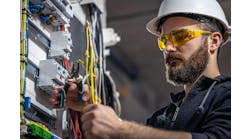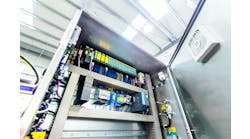Wrap it up: what you need to know about enclosures and the NEMA rating spectrum
The electrical enclosure is essentially a metallic box with a lid. To mount components in the box, a back panel on standoffs is added to create the finished enclosure. The application and environment dictate the variations on this base concept.
Starting with the enclosure itself, certain applications may call for a different material of construction. Environments where exposure to caustic or corrosive chemicals or extreme weather is expected, making the box out of fiberglass or polycarbonate ABS is a better option. In normal, dry conditions, a mild steel enclosure is suitable and for wet environments a stainless steel enclosure is best. The National Electrical Manufacturer Association (NEMA), came up with a rating system to describe these applications and environments and some of the main types are described as follows:
Type 1 is a general-purpose enclosure constructed for indoor use. This product protects against incidental contact from dust, light and indirect splashing but is not dust-tight.
Type 3R is intended for outdoor use. Deemed to be weather-tight, this type of enclosure is neither rain-tight nor water-tight, meaning that a direct stream of water or rain may breach the enclosure. For this reason, a Type 3R enclosure would be suitable for power or switchgear equipment but not recommended for control circuits.
Type 4 enclosures are considered weather-tight (weatherproof). They will protect the contents from falling rain, snow, sleet, dirt, wind-blown dust, splashing or hose-directed water. These enclosures will not be damaged by the formation of ice on the exterior surfaces but are not considered to be corrosion-resistant.
Type 4X enclosures are corrosion-resistant and are made of materials such as aluminum or stainless steel. They have the same properties of the Type 4 enclosure but are intended for extreme environments.
Type 12 enclosures are intended for indoor use and provide a degree of protection against solid falling objects, such as dirt, dust, fibers, dripping or light splashing water. These are usually constructed of mild steel.
Type 13 has all similar properties to Type 12 but adds a degree of protection against oil and non-corrosive coolants.
Generally, types 1, 4, 4X, 12 and 13 can be used indoors, while 3R, 4 and 4X can be used outdoors.
Click here for a full list of NEMA ratings.
When choosing an appropriate enclosure, the NEMA rating should be considered before any other criteria. Once that decision has been made, the type of access to the component inside the enclosure will dictate the next step in the selection process.
Generally speaking, the risk to personnel when exposed to the contents of the enclosure will determine the type of construction.
A pushbutton station, for example, is primarily a low-voltage enclosure where the lid will rarely be removed. As such, a four-bolt, removable cover is appropriate. A junction box might require infrequent opening (for troubleshooting or to add connections) and is generally mounted in a position where completely removing the cover isn’t practical. For this purpose, an enclosure with a hinged door and clamps would be an appropriate choice. The clamps require a screw driver or wrench to loosen the clamps and would provide a degree of protection that is higher than the same enclosure with hinged-lid that uses a quarter-turn latch that could be operated with a coin, for example.
For enclosures that contain voltages higher than 48 Vdc, an interlocked disconnect is required. Generally, there are two such types of disconnect panels. The first uses a through-the-door rotary actuator that locks the door in the closed position if the disconnect is in the ON position. The second uses a side-arm disconnect handle (lever-type) that uses a mechanical lever to prevent the door from being opened while the disconnect is in the ON position. Both options protect unauthorized or accidental opening of the door while the power is on but have an override feature so that the enclosure and contents may be accessed by trained personnel.
Always remember to follow proper arc-flash procedures when accessing panels above 48 Vdc. These procedures include the wearing of proper personal protective equipment (PPE) including clothing, face shield, gloves and footwear. The rules regarding this type of access are much more restrictive than in years past, so make sure to review the regulations regularly to make sure you are compliant.
As a contract packager of food products, our manufacturing processes dictate the use of pretty much the full spectrum of NEMA types and our enclosures come in all sorts of shapes and sizes. With any organization that has been around for a while, the use of enclosures was far less critical in earlier years, and this leads to a number of situations where the type of enclosure has changed as improvements have been made to our systems. As with all projects, make sure to consult the current rules governing such matters and make sure that you are compliant with the rules as they exist today. Generally, we stick to NEMA 4X for anything on our blending or dumping equipment while NEMA 12 works just fine for our general production equipment. We don’t package any corrosive products, nor do we have to consider explosion-proof equipment due to our current product mix. An evaluation of these criteria with each new product offering does give us confirmation that we are minimizing the risk to personnel when we introduce these new processes.
Something that has been of particular interest to my organization of late has been the introduction of products in the NEMA 4X realm, particularly sloped-top enclosures used in our ribbon blender operations. These mixers are used for a great variety of products and, as such, require frequent wet washes between product families. The popularity of gluten-free and organic products, as well as the ever-present allergens have also increased our need to wash (and test on a micro-biologic level) our blending equipment and rooms on a much more frequent schedule than ever before. The existing equipment was installed in 2000 with a more recent addition in 2012. Both the original and the addition use NEMA 4X enclosures, but we have learned that continuous washing over a number of years has rendered the enclosure seals to be less than fully functional. At the time we purchased this equipment, the enclosures came with a permanent seal that is installed at time of fabrication.
A new product (within the past year) has hit the market that directly addresses our current concerns. While still a NEMA 4X product, these new enclosures employ features that help to reduce the possibility of getting moisture inside the panels during the washing process. The first feature is a sloped top that, unlike previous version, extends the top surface of the enclosure over the top of the door. Previous versions employed a sloped top that stopped at the usual front face of the cabinet. The door was then a separate assembly that was attached to a flange that was welded to the front face of the enclosure. These new series of enclosures extend the top of the enclosure out over the top of the door to just past the front face. This feature creates a roof or porch over the door to force any water stream out past the top ledge and seal of the door.
The second feature is a new way of sealing the door. The traditional way of sealing an enclosure is a laid-in foam seal that is applied at time of manufacturing. If the seal fails, then one must either replace the whole door, if a current version of the enclosure matches the originals, or a kit must be applied that requires the removal of the old seal, cleaning of the surface down to the original metal and the application of a glue to lay down a new seal in place of the old.
The new seal is not a match for the old seal but is, rather, a roll of seal that must be applied one side at a time with appropriate cutting to length. In our experience, this process inevitably ends up with corners that are not continuous and a means by which water can get into the panel. These new enclosure are sanitary-washdown-rated. The key feature is a replaceable FDA-grade silicone gasket. These gaskets do not replace the existing seals on a non-washdown enclosure but would be used to replace the gasket on a newly installed enclosure. The silicone construction resists bacteria growth and chemical absorption, and the ease of replacement makes them an excellent choice for any new installation where NEMA 4X in a washdown environment is likely.
ALSO READ: Integrated safety and control design
[sideabar id=1]





